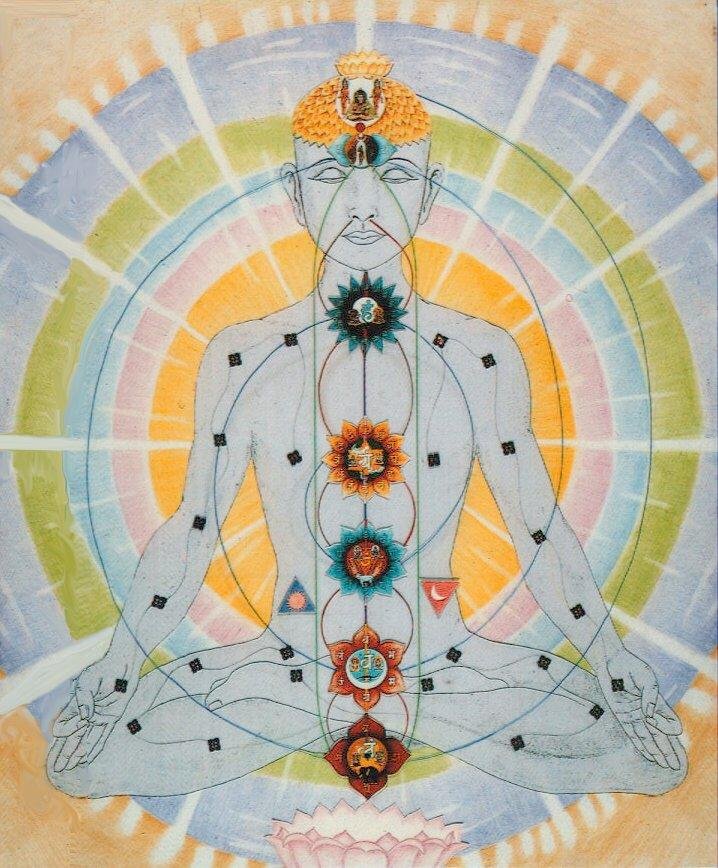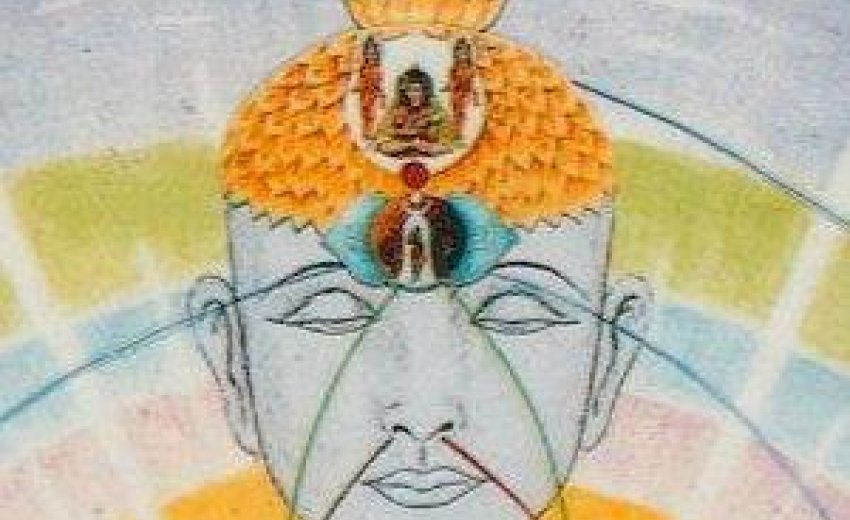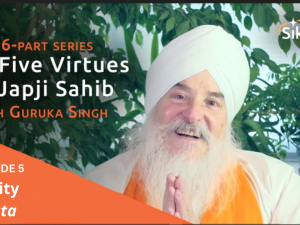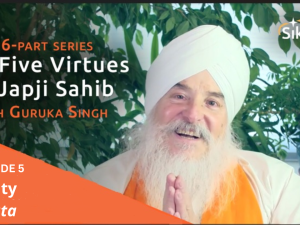 In the initial stages, it is best to practice Nam Simran while seated. Sit cross-legged on the floor keeping the spine as erect as possible, even if you are a bit uncomfortable at first. To avoid fatigue, a cushion may be used to sit upon for comfort. The practice of Simran in a sitting posture is more conducive to concentrated devotion. When practicing Simran, we must observe the golden rule of alertness and one-pointedness on the mantra. As one acquires proficiency, it does not matter whether Simran is performed seated, lying down or at work. When the practitioner has mastered the preliminaries of Simran, he will find that when his mind descends from a higher spiritual level, and he is again conscious of the world around him, he will find it easier to control his mind and body, if he is used to sitting upright. The posture will depend on the individual.
In the initial stages, it is best to practice Nam Simran while seated. Sit cross-legged on the floor keeping the spine as erect as possible, even if you are a bit uncomfortable at first. To avoid fatigue, a cushion may be used to sit upon for comfort. The practice of Simran in a sitting posture is more conducive to concentrated devotion. When practicing Simran, we must observe the golden rule of alertness and one-pointedness on the mantra. As one acquires proficiency, it does not matter whether Simran is performed seated, lying down or at work. When the practitioner has mastered the preliminaries of Simran, he will find that when his mind descends from a higher spiritual level, and he is again conscious of the world around him, he will find it easier to control his mind and body, if he is used to sitting upright. The posture will depend on the individual.
With progression of Simran, we soon attain a state of peace, balance and bliss. The first stage is the audible repetition of the Divine Naam. This is called Jaapa. In the initial stages, we practice by uttering the Divine Name or Naam aloud such as Saatinam or Wahe Guru. Just listening to the sound helps us to concentrate. At first, the mind does wander and concentration is difficult to attain. In this tug-of-war, irrelevant thoughts are bound to recur, but one need not despair. Thoughts will come and go. Keep coming back to the mantra and just let the thoughts come and go. Do not try to stop them. Just let the sound of the mantra continue. It will automatically filter the thoughts as they come and go. It is an automatic process. This is the beginning of Simran. Now is the time to experience God and achieve peace within. I am a sacrifice unto all the names of God.
It does not matter what faith one follows. Faith is bestowed upon us or we are born into one faith or another. Some have a choice later in life to embrace a faith but the essence of remembering the Creator is universal. As our Fifth Guru says:
The First Cause, the Merciful Karim, Rahim, the Merciful God, sustains all. Allah, is unknowable and transcendent. Khuda, is self-existent and Infinite. The Divine Lord, the Creator, pervades His entire creation. He is Jagan Nath, the Sustainer of creation, and He is Madho, the remover of fear. Remember Him in your heart, He is Rikkhikesh, Gopal and Gobind. He is Gracious, He is the unique Mullah, the Pir, the Prophet, the Shaikh. He is Narayan, Nar Hari, Dyal and Vasudeva. He lives everywhere in everything. His play is beyond understanding. O First Cause of all things, be merciful to me. Grant me the gift of devotion. Says Nanak, O my Maker the Guru has removed all my illusions. Allah and Parbrahm are exactly the same.
To utter the Name, one must make oneself receptive, and it does not matter what faith one is, the ultimate goal is the same, that is to long for peace and salvation.
Personally, I use the mantra ‘Waheguru’ for Simran but there are many names of God that will serve. (e.g. Ram, Om, Allah, Har, Hari, Gobind, Madho and many others.) Ultimately it does not matter. The power is in the mantra and what accompanies the utterance of it is for the person to feel and enjoy. When the spiritual seeker grows conscious both of the immanence and transcendence of God a sense of one’s own smallness and God’s vastness is evoked. It takes time for the spiritual seeker to attain a sublime spiritual experience and see and feel the One Light. The experience is wondrous.
It is a wondrous, ecstatic state, and in it one perceives the full meaning of the mantra and undersands the great mystery and wonder of existence which lies beyond words to express.
The second stage is the natural transition from Jaapa to automatic, silent mental Simran The lips cease to move, and yet the sound reverberates in the mind. This brings mental peace and dissipates all anxiety and anguish. As we grow spiritually, mental progresses naturally and unceasingly. Jaapa, the physical aspect of Simran, ends and mental repetition continues from day to day. The external attractions and distractions that once seemed so overwhelming begin to drop away and one feels happy and in a state of harmony all the time. Beginnings are always difficult and it is in perseverance that the real benefits are realized. All the powers of the mind which were diffused in attention upon external objects now begin to concentrate through the sweet, soft mental Simran. One experiences a flood of mental peace cascading through his whole being, the mind is at rest, the lips are motionless, and yet the Simran continues and burns like a lighted candle!
The third stage of Naam is absolutely marvellous as it promotes concentration and the gentle sound becomes more audible. The sounds of the external world fall into the background behind the silent sound of Simran and the wondrous mantra nourishes our body and soul.
This creates a state of oneness with God in which the mind relaxes and rests in the state of ‘shunia’ – the zero point of neutrality. This state of balance (Sahej) is achieved when the mind is at peace. This is truly a ‘peace that passes all understanding’ for it fills the mind and body and lies beyond the power of words to describe.
As Guru Ji, mentioned, those who have not experienced Naam are leading a useless, insipid life, and with this I am inclined to agree. The mind is in a state of ecstasy and is full of unfathomable bliss, and the joys of the world cannot compare to it. When we descend from this Sahej state, mental Simran begins and, through it we again ascend to this stage of peace, poise and joy.
As one great devotee said: In the first stages, there is Simran with the lips, and this is followed by mental Simran. Then the mind begins to rest in a state of poise and peace. When one experiences this state, one wishes to remain in it all the time and feels sad when leaving it. Turmoil, stress and anguish are unpleasant and distressing and immersion into Naam Simran allows us to achieve that inner bliss!
He adds, “ When somebody is performing Simran with the lips, followed by mental Simran, he stands apart from God and adores God, but when he draws nearer to God, Simran begins to drop away and there emerges a state of being-at-one and one drinks the heavenly nectar as a bee from a flower. It is like this: Take two pieces of iron, When the two pieces are welded together, they become one whole piece. Simran is like the welding, it joins the soul with the Infinite Soul. It takes long practice and self-discipline until the experience is achieved.”
The fruit of sahej is a state of blessing. The seeker feels as if he has received an electric current within him and waves of ecstasy surge through him. A wondrous thrill permeates his being; there is boundless, overflowing joy; he is steeped in an ocean of bliss; he feels inebriated with bliss. When he turns his mind to his ears he hears sweet melodies coming from the universe and the mind is filled with a celestial symphony comprised of all sounds. This state of Sahej brings immediate Divine knowledge which is experienced directly. The bliss of Sahej infinitely excels the pleasures of the flesh in intensity and is exhilarating, invigorating and health rejuvenating. Only when we taste the bliss of Naam do we lose the craving for worldly pleasures. As Bhagat Kabir Ji, says, when we taste spiritual bliss, the pleasures of the flesh lose their relish. Relying on guidance and inspiration from enlightened souls we can put the methodology of Naam Simran into practice and achieve spiritual advancement.
With Naam Simran, the yogic practices of meditation come into play. Yoga and meditation enable the seeker to gain insight into the practical aspects of achieving Naam Simran and preparing for relaxing the body and mind to be receptive to uttering the Nam of the creator. Yogi Bhajan came to the West in 1969 with a clear aim to create teachers of Kundalini yoga and meditation. Kundalini yoga is a physical and meditative discipline, comprising a set of techniques that use the mind, senses and body to increase awareness. It focuses on psycho-spiritual growth and the body’s potential for maturation, giving special consideration to the awakening of the latent energies in the body as Naam Simran does. In fact, Kundalini Yoga as taught by Yogi Bhajan includes Simran as part of its practice. For the restless mind, the practice of Kundalini Yoga quiets the mind, increases awareness and helps to implant the seed of Naam within the heart and mind. Kundalini Yoga is known as the yoga of awareness.
Yoga, a Sanskrit word meaning union is derived from the root yuj, to yoke. Its principal meaning is the joining together of our fragmented self, yoking of our mind which seems ever ready to ‘fly out’ through the senses, to bring it under one’s control. There are many paths that all lead to the same end: meditative absorption.
Interest in yoga has very recently awakened worldwide and many are attracted to it for genuine spiritual realization and fulfilment which has evidently changed many people’s lives for the better.
It is worthwhile knowing what the law of spiritual life is all about:
1. Whatever we take to be real for the time being, affects our personality, thoughts, emotions and actions. Our whole being responds to this perceived reality.
2. Our concept of reality depends upon our concept of ourselves, that is, one’s conception of God evolves with the evolution of one’s consciousness.
3. Spiritual awakening is the transformation of one’s consciousness, which means moving the attention and energies from the lower centres (charkas) to the higher centres of consciousness.
4. Though distinct from the moral imperative, spiritual aspiration must be supported by it. The practice meditation must be accompanied by purification of mind and sublimation of instinct.
5. Every person must first understand and accept where he or she is now in his or her consciousness and begin from there, making the best use of the protection and support given during the early years of life, one must outgrow them and stand on one’s own two feet, drawing sustenance more from the Divine than from other sources such as institutions and people. This is the law of spiritual growth, and this will enable one to move forward on the spiritual path.
6. The realization of the One - the transcendental Reality - lies always through personal experience. No one else’s experience can be your experience.
7. The more our consciousness expands, the more we see the Divine in all people and all things, and the more spiritual we become.
The Guru, spiritual guide or teacher guides and teaches the techniques to assimilate our practices. Gur = formula. Guru = the giver of the formula. Literally GU = darkness and RU = Light. So the word Guru etymologically means the one who removes darkness and ignorance in others and brings light to them. The need for a Guru is very crucial. The power becomes manifest only in a pure soul who yearns for the Divine and surrenders the ego. It is this act of surrender that is the catalyst for transformation. Ultimately all initiation is self-initiation. Association with others who do sadhana is known as Sadhsangat and it is important to achieve purity of mind and upliftment. Associating with others who can uplift you as you uplift them is of paramount importance. As the great teacher of Yoga, Patanjali stated: purity of kinship is a fundamental need in spiritual life and it is prayer, meditation and chanting which, when methodically practiced, create a new harmony which purifies our thinking, feeling and awareness
Swami Brahmanda said: “The easiest way to purify and steady the mind is to retire into solitude, control all the cravings and engage in contemplation. The more you occupy the mind with the holy thought, the greater will be your spiritual unfolding. Just as a cow yields much milk when it is well fed, so when the mind is fed with spiritual food, it will yield greater tranquillity. Spiritual food consists of meditation, prayer, contemplation and japam (chanting of mantra or Divine Name). But as we learned from Guru Nanak Dev Ji, solitude is not viable for a fully spiritual life. Anyone can meditate in a cave – far from distractions – but they way of the true saints is to live fully in the world, but not of it. The whole world rests on the householder. So the true aim of life is to balance work, family, meditation and rest and live a balanced life. Being a fanatic is easy. Being lazy is easy. Being balanced requires effort and self-discipline.
Another way to steady the mind is to let it wander but keep a steady watch over its wandering. After a while the mind itself becomes tired and comes back to find peace in God. If you watch your mind, your mind will in turn keep watch over you. (The Eternal Companion pp 251-252 by Swami Prabhavanada.
The most important qualification for a spiritual aspirant is the deep inner commitment to work on oneself.
Patanjali has placed before us a spiritual ladder with eight steps that takes us to perfection:
The first step called Yama means the observance of the five virtues: ahimsa (non-violence); satya-truth; astaya (not stealing); brahmacharya (continence); and aparigarha (not depending on the charity of others.)
Then comes niyama or the five rules of conduct: Sanca-the purity of mind and body; santosa-contentment, has to developed; tapas-austerity in life; sradhyaya-self study; also reflecting on what is learned and making it your own; Isvara-pranidhana, self-surrender to God, that is surrender of the ego.
The third step is asana; sitting still and allowing oneself to become calm.
The fourth step is pranayama - control of the breath. When one can control one’s breath, the mind follows. Pranayam is the key to controlling the mind.
The fifth step is pratyahara – awakening of the neutral mind. If you wish to meditate, you must detach your mind from mundane things and come to the shunia or neutral point where pleasure and pain are one and the same.
The sixth step is dharana which means concentration on the mantra or yantra - on a Holy word or on a Holy, blissful Form in a particular centre of consciousness.
The seventh step is Dhyana – absorption in the object of contemplation. This then leads to the final highest state, Samadhi or the super-conscious state. This is also known as the Turiya state.
Kundalini yoga combines breathing, movement, meditation and relaxation. It is the science of sequence, rhythm and sound, which works on every aspect of the body, mind and soul. One cannot achieve the same effect through physical exercise in a Gym or health centre! The endorphins secreted during exercise are only transient but the effects of cumulative meditation are lasting and beneficial both to soul and body. Naam wipes out all maladies and keeps the individual healthy. No previous experience in yoga or related disciplines is required for one to achieve the benefits almost immediately. Over a period of time, this practice provides the physiological and psychological prerequisites for total health including a balanced glandular system, strong nervous system, expanded lung capacity and the clearing the emotional blocks.
Kundalini yoga is a holistic philosophy that brings practical benefits of rejuvenation and healing. It is a comprehensive system of exercises, breathing, meditation, chanting and a healthy mental projection. It allows the seed of Naam to easily sprout and grow in the consciousness. In this way, we develop a conscious and dynamic relationship between our personal life energy and the universal flow of Prana. The overall result is the opening and balancing of the chakras and the alignment of all the ten spiritual Bodies.
This awakens us to who we really are: spiritual beings having a human experience.
BACK Part 1 - (Part 2 of 3) - Part 3 --> NEXT





